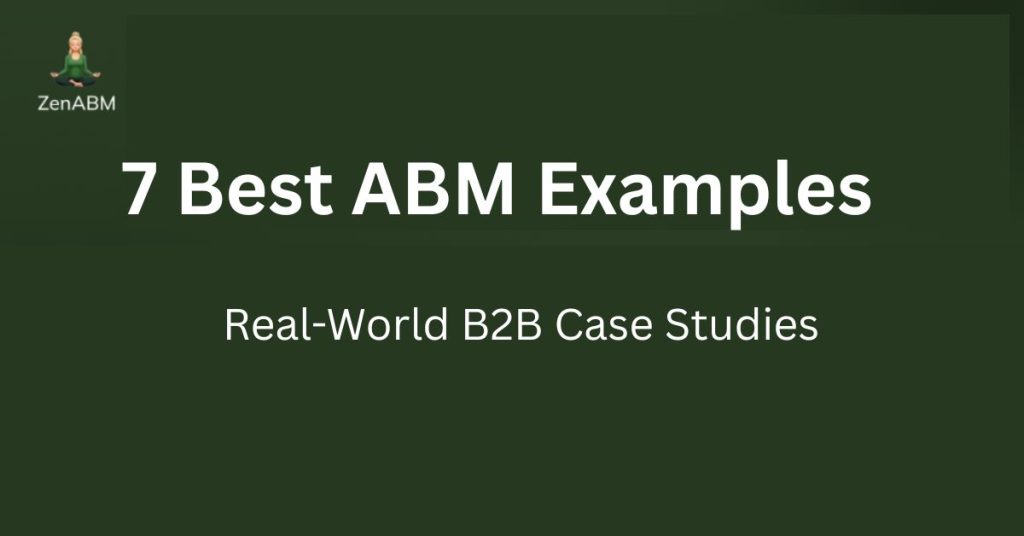In this guide, I break down seven real‑world B2B account‑based marketing examples and why they worked. We focus on the best ABM examples that teams can copy without guesswork.
For each example, I call out the exact tactics and the measurable outcomes so you can move fast.
Read on, lift the play that fits your motion, and see how ZenABM can support your account‑based marketing program.
7 Best ABM Examples: Quick Summary
- Snowflake: Combined premium direct mail with tailored digital experiences, hitting 85 percent open rates and sourcing more than 50 million dollars in pipeline.
- Salesforce: Activated intent signals, personalized email tracks, and executive healthcare webinars, adding 32 percent to the pipeline.
- Adobe: Used AI‑driven personalization for Fortune 500 accounts, lifting average deal size by 60 percent and retention by 40 percent.
- Engagio: Orchestrated multi‑channel motions across email, LinkedIn, direct mail, and sales to achieve 300 percent higher engagement and 35 percent faster cycles.
- Drift: Deployed conversational chat with real‑time IP recognition and grew qualified leads by 250 percent.
- DocuSign: Built industry‑specific content hubs that produced 60 percent higher engagement, 300 percent more page views, and a 22 percent pipeline uplift.
- LiveRamp: Ran high‑touch outreach with custom ads, email, and direct mail, converting 33 percent of cold accounts to meetings in four weeks.
How ZenABM Amplifies Your ABM Results:
- LinkedIn Ad Tracking: Captures company‑level ad engagement and pipes insights directly into your CRM.
- Real‑Time Account Scoring: Routes accounts to reps the moment engagement spikes.
- Buyer Intent Insights: Surfaces what each company cares about so you can personalize outreach and retarget with precision.
Choose the tactics that match your goals and use ZenABM to scale the impact.

Best ABM Example #1: Snowflake’s Hyper‑Personalized Direct‑Mail ABM
Snowflake, a cloud data platform, executed one of the strongest account‑based marketing case studies by pairing premium direct mail with rich digital experiences. They combined highly personalized mailers with targeted online content.
The team did deep research on 200 large accounts such as Walmart, Kaiser, and JPMC, then created custom data visualizations and reports aligned to each account’s objectives. Think retail analytics for Walmart and healthcare insights for Kaiser.
Packages shipped as elegant booklets or on premium tablets and showcased projected ROI, plus the exact Snowflake solutions that solved the account’s problems.
With high‑touch mailers and tight digital tracking working together, Snowflake reported 85 percent open rates and more than 50 million dollars in pipeline from only 200 accounts.
Each account represented a five‑ to six‑figure opportunity.
Key tactics from this example:
Deep Account Research
Document each target’s pains and KPIs. Build bespoke collateral like charts, ROI tools, and case studies that speak directly to those needs.
High‑Quality Creative
Use premium formats like tablets, hardcover booklets, or branded kits so the package stands out and earns attention. Ensure projected deal value justifies the spend.
Integrated Digital Follow‑up
Embed QR codes or unique URLs to track engagement. Snowflake’s kits drove recipients to a tailored welcome page or demo sign‑up that alerted sales for fast follow‑up.
Sales Alignment
Arm reps with account briefs and next‑best actions. Marketing and SDRs coordinated outreach as soon as a prospect engaged, which improved conversion.
By pairing handcrafted content with data‑backed personalization, Snowflake’s ABM program drove standout engagement and pipeline.
You can adapt this by lowering unit cost while keeping the research depth, personalization, and measurement that make it one of the best ABM examples to emulate.
Best ABM Example #2: Salesforce’s Healthcare Intent‑Based ABM
Salesforce, known for CRM and cloud software, ran a healthcare‑focused motion powered by intent data. They targeted hospitals and health systems actively researching CRM solutions and layered outreach that included personalized email sequences, invite‑only executive webinars, and premium content.
Messages referenced each hospital’s priorities, like patient experience and compliance.
Results were strong. Salesforce attributed a 32 percent pipeline increase to these healthcare accounts.
Steps and tactics you can lift from Salesforce:
Intent Signals
Use platform data or third‑party sources to identify in‑market companies that consume healthtech content or visit EMR pages. Pilot campaigns across TOFU, MOFU, and BOFU to spot accounts engaging with your ads. Vary creative by value proposition or feature to reveal what each account cares about most. You can execute this using ZenABM.
It pulls company‑level impressions for every campaign and campaign group:
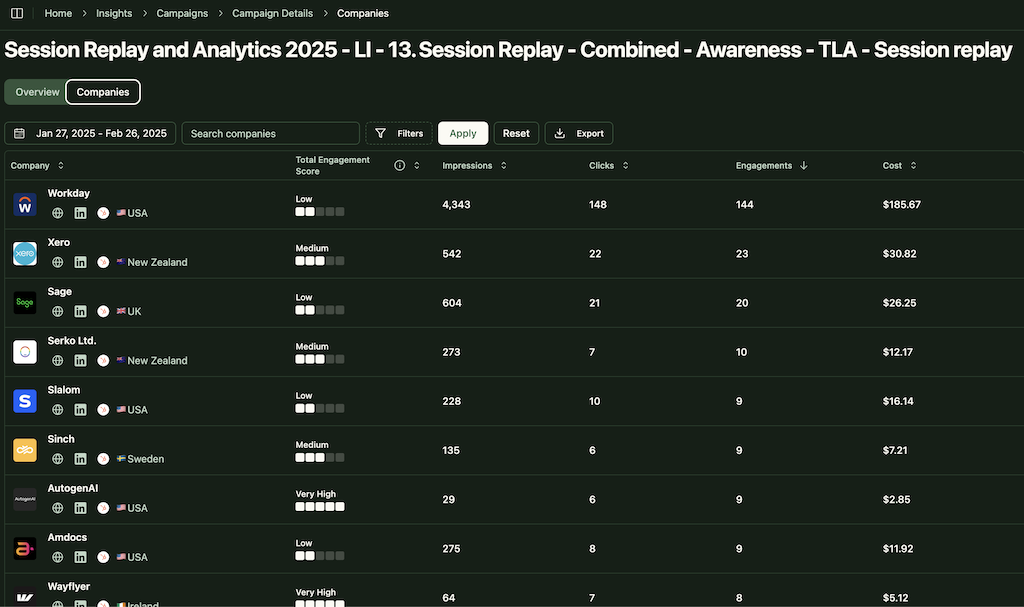
Then it syncs the same engagement data to your CRM so sales can act on it quickly: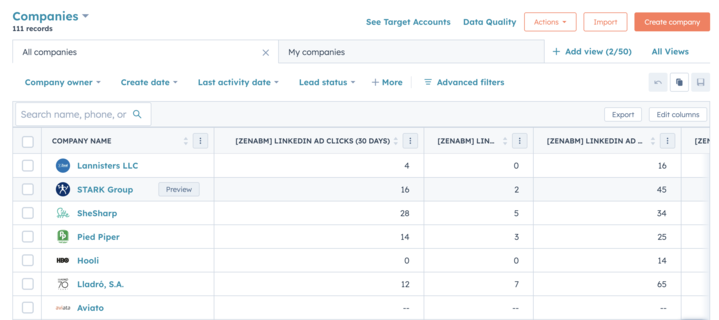
You can also tag each campaign by the intent it promotes. ZenABM will group accounts that respond to the same message:
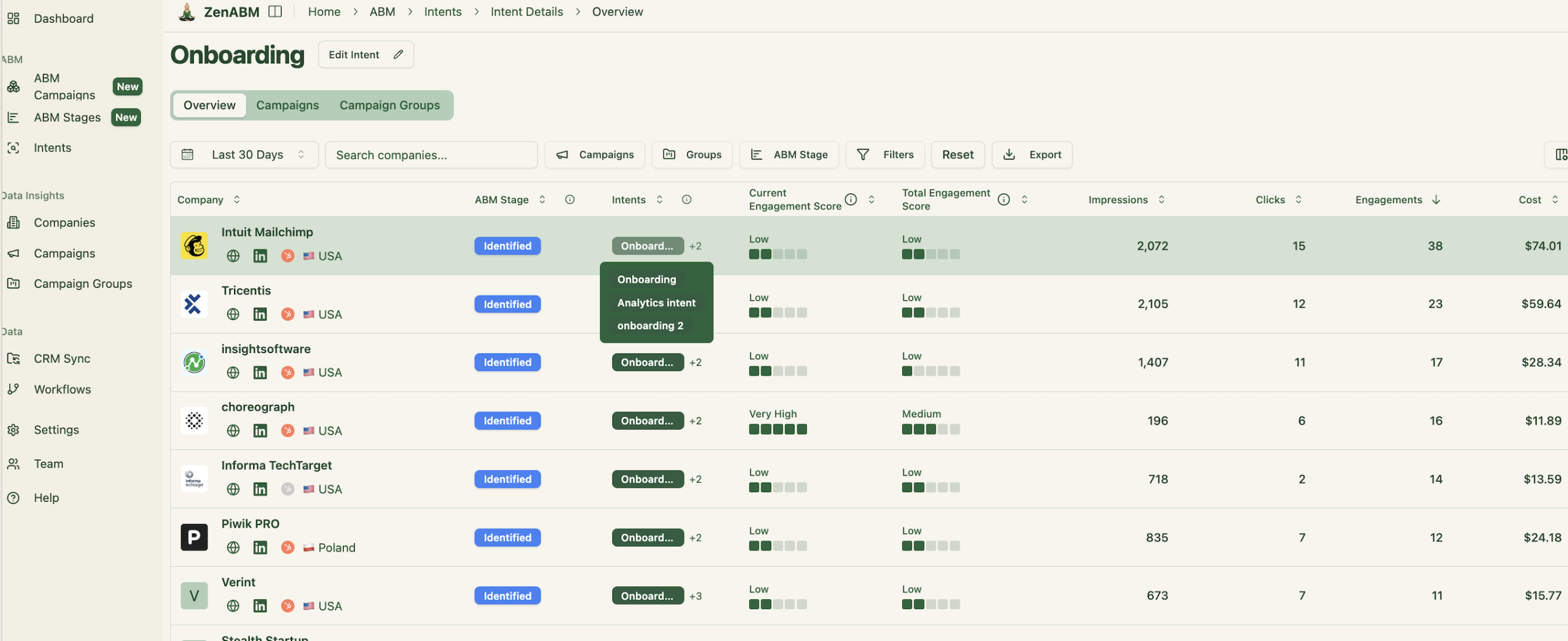 This view shows which companies are in market for the exact solution you provide.
This view shows which companies are in market for the exact solution you provide.
Hyper‑Personalized Emails
Send campaigns that reference the account by name and link to relevant case studies from the same industry.
Exclusive Webinars
Host invite‑only roundtables or briefings for decision makers. Salesforce curated executive sessions on healthcare technology trends and positioned them as exclusive.
Sales Touchpoints
After each marketing touch, coordinate fast sales follow‑up. A webinar RSVP or whitepaper download should trigger a tailored outreach sequence.
By narrowing to one vertical and aligning sales with marketing at every step, Salesforce warmed up cold accounts. Personalization at each stage fueled the 32 percent pipeline lift.
Any SaaS team can copy this ABM case study by focusing on a single industry, applying intent data to selection, and layering email, events, and direct outreach.
Best ABM Example #3: Adobe’s Data‑Driven Fortune‑500 ABM
Adobe shifted from broad demand generation to focused account management for large enterprises. They prioritized Fortune 500 companies and used AI and predictive analytics to guide targeting and messaging.
With live engagement data across web and campaigns, Adobe delivered account‑level personalization.
For example, if a CMO at a target bank consumed retail content, the next touch highlighted Adobe’s retail analytics capabilities.
Results followed. Adobe reported a 60 percent jump in deal size and a 40 percent increase in retention among these accounts.
Key tactics in Adobe’s approach:
- AI and Predictive Models: Mine customer data to find high‑value lookalike accounts.
- Real‑Time Behavior Tracking: Stream account signals and tailor the next touch. If the CFO of Bank X viewed an AI infographic, the follow‑up was a CFO‑focused case study.
- Personalized Content Journeys: Build alternative versions of emails and landing pages that swap based on account context.
- Executive Sponsorship: Pair digital touches with outreach from senior leaders who can open doors and reinforce the relationship.
The lesson is clear. Use predictive models to select targets and tailor the journey to the account’s real behavior. That is what turns good plays into the best ABM examples at enterprise scale.
Best ABM Example #4: Engagio’s Multi‑Channel Orchestrated ABM
Engagio, now part of Demandbase, championed coordinated account orchestration. Instead of running channels in silos, they mapped a unified plan for each account and sequenced messages across LinkedIn, email, direct mail, events, and sales calls.
A typical flow started with an SDR’s LinkedIn message, followed by a personalized email, then a tailored mailer, then a VIP event invite. One story. Many touches.
What made this example stand out:
- Account Journey Mapping: Define the ideal path and assign channel touches to each stage.
- Central Orchestration: Use software so marketing, sales, and events know when to activate and keep messaging consistent.
- Sales Alignment: Share one account view. When a prospect engages with direct mail, the rep knows the exact piece and continues the story.
- Real‑Time Optimization: Monitor engagement by channel and tune frequency and timing to keep momentum without spam.
This orchestration drove 300 percent higher engagement and shortened cycles by more than 35 percent compared to non‑ABM cohorts. A textbook account‑based marketing example for complex deals.
Best ABM Example #5: Drift’s Conversational AI Chatbot ABM Strategy
Drift used 1:1 personalization with on‑site chat to target key accounts. When a visitor from a target company arrived, reverse IP identified the firm and triggered a custom chatbot greeting.
The message referenced the visitor’s company and likely pains like risk reduction for finance teams and invited the user to learn more.
This immediate relevance captured attention.
The bot qualified in real time and routed sales‑ready visitors straight to reps.
Core elements in Drift’s approach:
- IP‑Based Identification: Detect target accounts on‑site and present tailored content.
- AI‑Powered Messaging: Build flows by industry or need. For example, a HubSpot visitor saw an integration‑focused prompt, while a Salesforce visitor saw a competitive angle.
- CRM Integration: Send conversations into your CRM with account tags so sales has full context.
- Measurement: Easy to track. One report credits the ABM chat motion with a 250 percent increase in qualified leads versus generic experiences.
This conversational play scales personalization without heavy manual work. Ideal for SaaS teams selling to tech‑forward buyers when IP data is accurate and flows are well tested. Another of the best ABM examples for pipeline velocity.
Best ABM Example #6: DocuSign’s Industry‑Focused Content ABM
DocuSign ran a one‑to‑many motion by building industry‑specific experiences. They selected six core verticals such as legal, finance, healthcare, and manufacturing, then created content paths for each.
Visitors from target industries landed on tailored pages with relevant case studies, testimonials, and resources. A healthcare lead saw HIPAA content. A legal leader saw e‑discovery proof points.
Impact was immediate. Engagement rose by 60 percent, page views tripled, and pipeline grew by 22 percent among targeted accounts.
How to replicate this example:
- ICP and Segmentation: Choose a small set of industries or segments and design around them.
- Content Personalization: Map existing assets to each segment and use website tools to swap content dynamically.
- Landing Pages and Messaging: Stand up microsites or pages per industry with logos, testimonials, and copy that speaks the segment’s language.
- Web Analytics: Track which vertical content performs best and iterate.
Treat each vertical like its own campaign. The relevance pays off. This is one of the cleanest B2B ABM examples for teams with strong content libraries.
Best ABM Example #7: LiveRamp’s High‑Touch Multichannel ABM
LiveRamp, a data connectivity SaaS, piloted a classic high‑touch program for a small set of strategic Fortune 500 targets. They selected around 15 accounts and layered personalized display ads using each company’s name or data points, custom email sequences, physical direct mail, and coordinated sales outreach.
A prospect might receive a branded infographic in the mail, then see ads reinforcing privacy and compliance, then get an email referencing the exact materials they viewed.
SDRs are called with context for a smooth handoff. Results included:
- Thirty‑three percent conversion from cold target to meeting within four weeks, which is outstanding for an enterprise.
- Twenty‑five times growth in customer lifetime value over two years, turning small wins into long‑term relationships.
What to emulate:
- Hyper‑Personalization: Make every touch custom. Ads reference company specifics. Emails address named challenges.
- Tightly Coordinated Outreach: Marketing and SDRs move in lockstep so reactions to ads or mailers get fast, relevant follow‑up.
- Measurement by Account: Track impressions, clicks, and replies at the account level and feed that to CRM to focus on hot accounts.
This worked because no account was treated like a generic lead. Bespoke creative and cadence across digital and physical channels produced durable engagement and pipeline growth. It is one of the best ABM examples for strategic accounts.
How ZenABM Can Help with ABM On LinkedIn
ZenABM is built for LinkedIn Ads ABM.
Here are the core capabilities:
Company‑Level Engagement Tracking Per Campaign from LinkedIn’s Official API
ZenABM ingests company‑level ad engagements, including impressions, from LinkedIn’s official API.
You can view impressions, engagement, spend, CTR, and more for every company.

Pipeline and Revenue Impact Analysis
ZenABM matches engaged companies with opportunities in your CRM to quantify ad impact on pipeline and revenue:

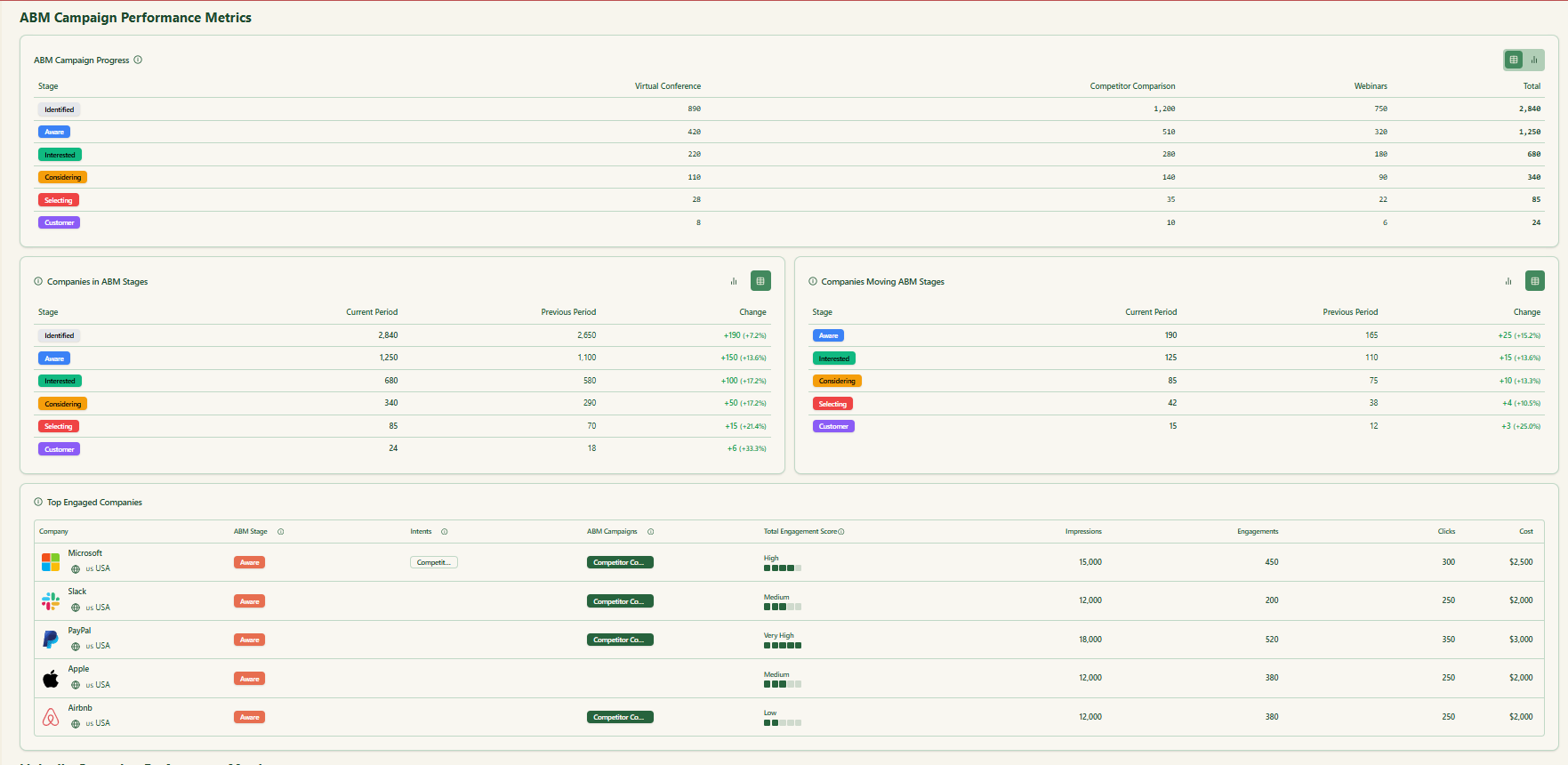
You can define your own minimum impressions to classify a deal as ad‑influenced.
Real‑Time Account Scoring and Automated BDR Assignment
ZenABM calculates a current engagement score for each company based on recent touches. When a score crosses your threshold, ZenABM updates its ABM stage in your CRM and triggers handoff to sales.

Buyer Intent Insights
When you run multiple use‑case campaigns, ZenABM reveals which companies engage with which narratives. Reps get a concrete conversation starter without complex workflows:  It also writes the intent as a company property in your CRM:
It also writes the intent as a company property in your CRM:
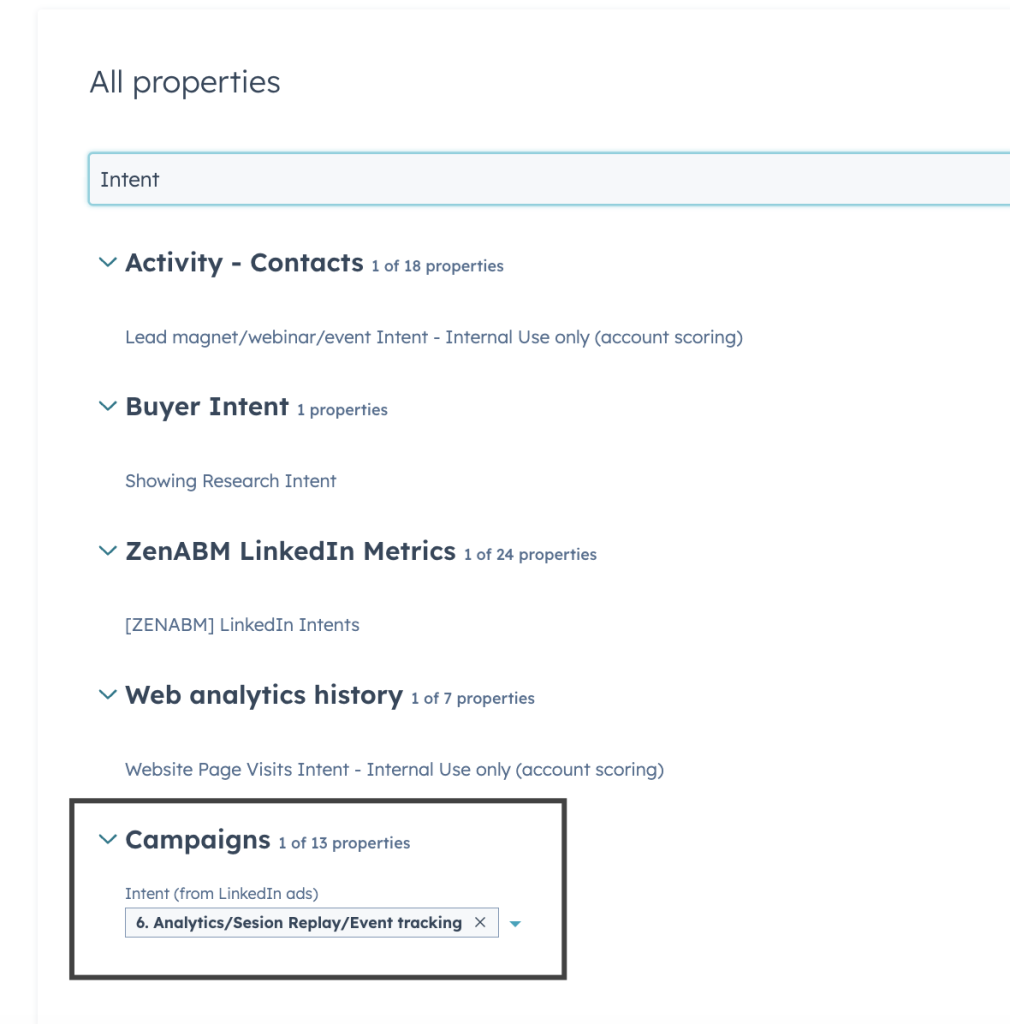
Stage Tracking
Stage tracking is available, and you can define thresholds for each stage: 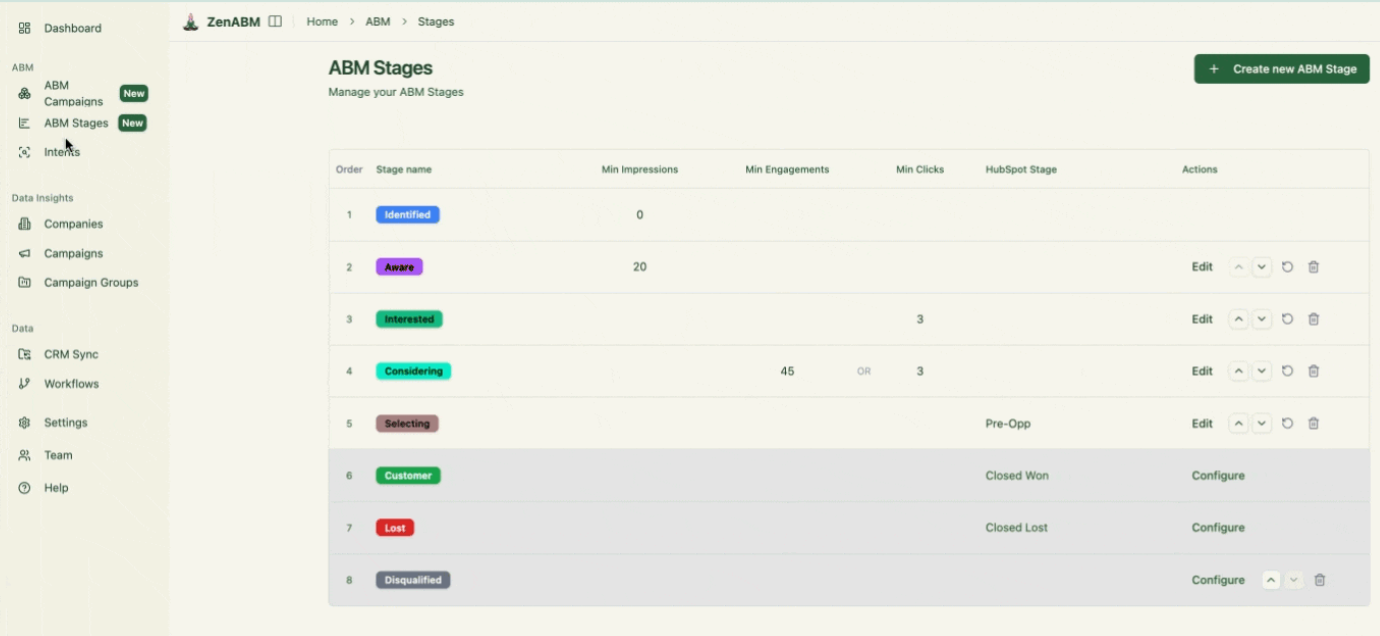
Effortless Retargeting
Use ZenABM to export lists of companies that engaged with each campaign or use case. Then retarget those accounts with relevant ads or personalized outreach.
- Launch your first LinkedIn ad sets by use case.
- Identify viewer accounts inside ZenABM.
- Cross‑check with open opportunities in your CRM.
- Ship follow‑up ads or sequences aligned to expressed interest.
Over to You
In this guide, we explored seven tactical and successful B2B SaaS examples of ABM, each with steps you can replicate. From Snowflake’s premium mailers to Salesforce’s intent‑led healthcare motion, Adobe’s AI personalization, Engagio’s cross‑channel orchestration, Drift’s conversational chat, DocuSign’s industry paths, and LiveRamp’s high‑touch outreach, these plays prove that focused account execution moves the pipeline.
The takeaway is simple. Great results come from deep personalization, precise account selection, and tight sales and marketing alignment. Tools like ZenABM make the best ABM examples easier to run with clean attribution and CRM sync.
Now it is your turn. Pick the motions that match your B2B goals and put them to work.

